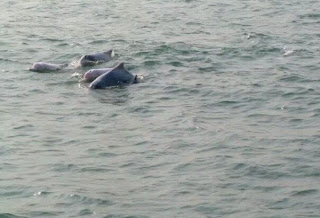
Spotted and Unspotted Chinese White Dolphins surfacing. (Photo still from my video clip, hence the poor image quality)

A Finless Porpoise- note the lack of the dorsal fin on its back and it also does not have the long snout (rostrum or beak) that most dolphins have. (Photo by HKDCS)
It is unbelievable to see cetaceans in Hong Kong for me because I don't know how they are able to co-exist alongside humans in such a dangerous place that is so densely populated, developed (still developing- e.g. HK-Zhuhai-Macau Bridge) and polluted. As Hong Kong is an important port, massive cargo ships, container boats and high speed ferries are a common sight, so common it has become part of the waterscape. Fishing boats (e.g. trawlers & gill nets) both large, small and sometimes illegal ones are seen in our waters, puffing out black soot from their noisy engines, further exacerbating the water and noise pollution problem.
 Quite a few dolphin sightings were seen in the middle of these high traffic areas and it was very disconcerting. I couldn't help but shed a tear or two (or three) because it made me think what difficult lives they must have, constantly having to be on the alert for boats, and it must be stressful for them to find food and take care of themselves and their young in such a busy environment- their home. Mother dolphins that were seen by the staff and interns sometimes appear to have lost their babies after a few months as the baby was nowhere to be seen, and many of the Chinese White dolphins I've come across during the boat survey trips have dorsal fins that are broken or sliced apart due to entanglements with fishing gear or boat strikes, one even have only half of its tail fluke left. It is certainly a very sad sight to see- dolphins stranded (although I haven't seen a stranded dolphin yet- only heaps of photos) or bearing human related scars. However, even with scars, these lucky dolphins still swim and splash about gracefully, illustrating how strong and adaptable they are. :)
Quite a few dolphin sightings were seen in the middle of these high traffic areas and it was very disconcerting. I couldn't help but shed a tear or two (or three) because it made me think what difficult lives they must have, constantly having to be on the alert for boats, and it must be stressful for them to find food and take care of themselves and their young in such a busy environment- their home. Mother dolphins that were seen by the staff and interns sometimes appear to have lost their babies after a few months as the baby was nowhere to be seen, and many of the Chinese White dolphins I've come across during the boat survey trips have dorsal fins that are broken or sliced apart due to entanglements with fishing gear or boat strikes, one even have only half of its tail fluke left. It is certainly a very sad sight to see- dolphins stranded (although I haven't seen a stranded dolphin yet- only heaps of photos) or bearing human related scars. However, even with scars, these lucky dolphins still swim and splash about gracefully, illustrating how strong and adaptable they are. :)
Further information and ideas on what you can do to help can be found in the following publications by the Hong Kong Dolphin Conservation Society.
Taking away their freedom and placing cetaceans (whales and dolphins) into captivity as a means to conserve their population would not be the answer to this. Placing cetaceans into captivity in the name of conservation and research, then training them to do stunts to entertain people and for profit is even worse. Instead, we should aim to involve ourselves into more direct conservation efforts, such as choosing humane or organic food products, purchasing less electronics, recycling, writing letters to legislators to demand policy changes for better management and protection of our environment, and participating in public forums and consultations during the Environmental Impact Assessment process. Most importantly, think before you buy a ticket to marine parks, where captive dolphins and whales perform unwillingly for our entertainment.
17(+) Chinese White Dolphins decided to surprise us on Thursday 23rd December while we were looking for Finless Porpoises! They surrounded our boat and stayed with us for quite a while (we would love to watch them all day but we had to leave)! They were all very active, showing off their unique colors, patterns, graceful jumps and porpoising out of the water- the best and most gorgeous water acrobats!

Look! The baby! You see how small the baby (cutie in grey) is compared with its mother (lady in pink)?!!
look at that mini dorsal fin ♥ :D

Greetings from a lovely Chinese White Dolphin with one of my favorite quotes. It's become our nature to rely on others to do the work and this applies to many other issues too. Animals cannot speak for themselves, so act now and join us in saving our precious wildlife before it's too late!

No comments:
Post a Comment